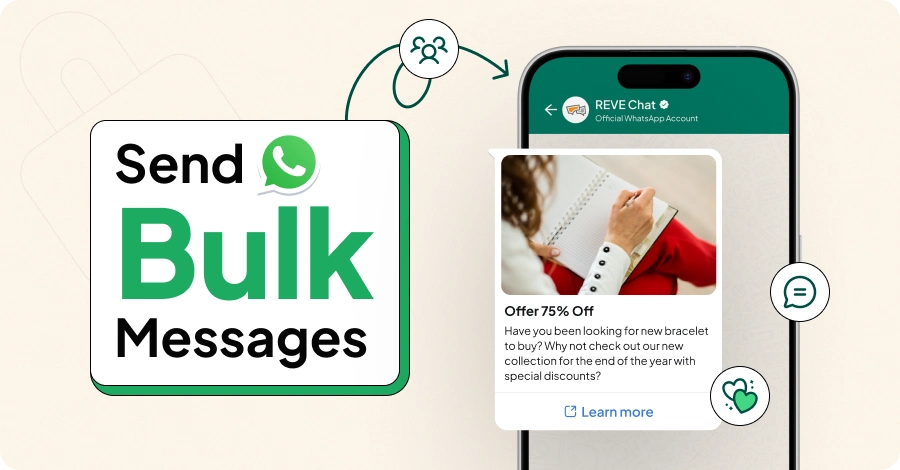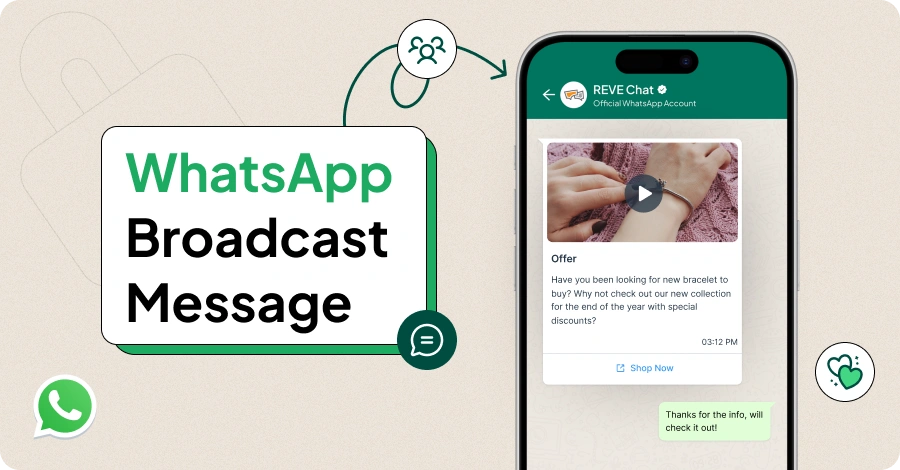Relationship Marketing: Definition, Types, Benefits & Examples
- February 2, 2024
- 16 mins read
- Listen

What is Relationship Marketing?
Relationship marketing refers to the marketing strategy of building meaningful relationships with customers to gain brand loyalty and achieve long-term customer satisfaction. It’s a key facet of customer relationship management (CRM) that focuses on long-term engagement over short-term goals like sales and acquisition. The main purpose of using relationship marketing is to keep customers delighted and maintain their trust for long. This form of marketing places more value on creating strong customer connections to a brand that can result in promotion and generate leads. Unlike the transactional marketing approach that emphasizes increasing the number of individual sales, relationship marketing is more focused on retaining existing customers and winning them back in the future. It’s about giving continued value through relationship measures and converting them into brand loyalists.
The main purpose of using relationship marketing is to keep customers delighted and maintain their trust for long. This form of marketing places more value on creating strong customer connections to a brand that can result in promotion and generate leads. Unlike the transactional marketing approach that emphasizes increasing the number of individual sales, relationship marketing is more focused on retaining existing customers and winning them back in the future. It’s about giving continued value through relationship measures and converting them into brand loyalists. Transactional Marketing Vs Relationship Marketing: Key Differences
| Transactional Marketing | Relationship Marketing |
| A form of marketing that focuses on targeting customers for one-off sale transactions | A form of marketing that focuses on retaining and satisfying customers |
| It has a short-term approach towards customers | It has a long-term approach towards customers |
| Sales-focused approach | Customer-centric approach |
| Infrequent and low levels of customer contact | Frequent and high levels of customer contact |
| Prioritizes transactions | Prioritizes building trust with customers |
| No focus on customer engagement | High focus on customer engagement |
| Customer relationships are short and intermittent | Customer relationships are enduring and robust |
| Lack of emphasis on customer commitment | Total commitment to customer trust and commitment |
Why is Relationship Marketing Important?
According to Harvard Business Review, acquiring a new customer can be five to 25 times more expensive than retaining an existing one. When a business prioritizes customer acquisition over retention, it faces more challenges and has to spend more. In contrast, following the retention strategy can lead to engaged customers who are more likely to stay with the business and add value over time. Relationship marketing is important because it helps you retain customers long-term. This form of marketing contributes to customer loyalty and loyal customers spend more and make repeat purchases. By using relationship marketing, a business can stay in close contact with customers and understand their needs better. In addition, building relationships can help a business know how customers use a brand’s products and services, and then use the information to create new features and offerings. This is how positive connections are formed with customers. A continued focus on building connections can also help increase the lifetime value of customers. Building relationships leads to satisfied customers who are more likely to stay with your business and less likely to switch over to competitors.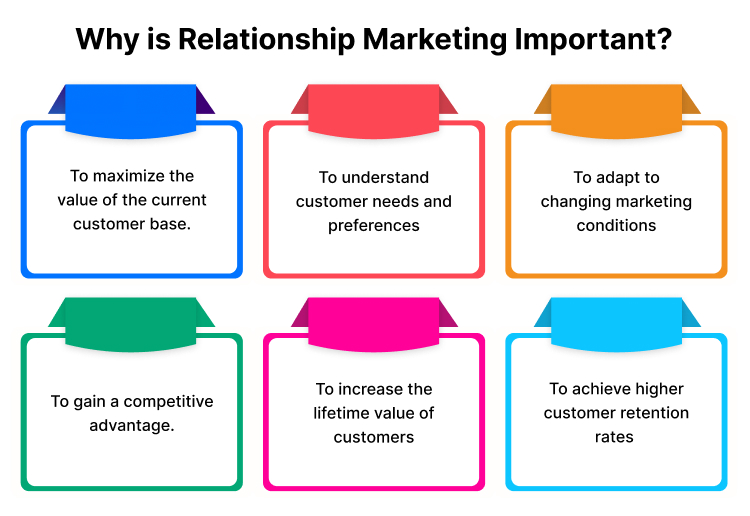
3 Key Features of Relationship Marketing
1. Concern
A business can never establish solid connections with customers without understanding their needs. To know customer needs, it’s important to be concerned about their worries and issues. The more a business is concerned about customer satisfaction, the better relationship it can forge over time. This is why “concern” is one of the three key features of relationship marketing.2. Trust and Commitment
Building trust measures with customers is essential for forging long-term relationships with them. The more you gain a customer’s trust and commitment, the better connections you can make. The overall growth and success of your business will depend on the level of trust and commitment you have from your customers. This is why prioritizing long-term trust over short-term gains is one of the key features of relationship marketing.3. Service
The quality of customer service you provide will decide the strength of the relationships you forge with your clients. Providing great customer service can enhance the overall customer experience. And when customer experiences are positive, it results in customer satisfaction and loyalty. Loyal customers stick for longer which leads to customer relationship profitability.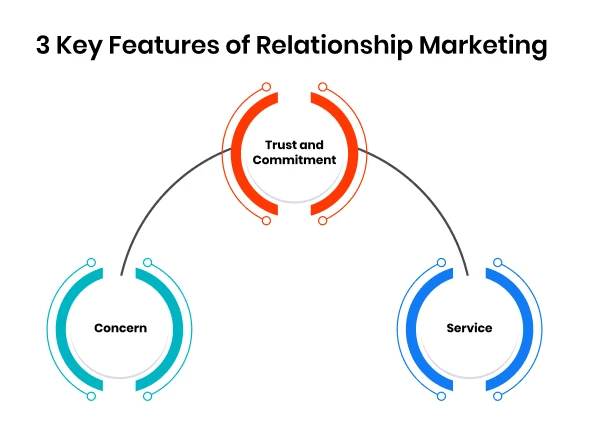
Benefits of Relationship Marketing
- Higher Customer Lifetime Value (CLV) – Customers become loyal to a brand that continuously takes steps to build relationships with them over time. They also show more trust and confidence in a business that cares for them and helps them through problems. Since loyal customers stay for longer, it leads to repeat purchases and a higher CLV. They are also more likely to recommend products and services to family, friends, and colleagues.
- Lower Marketing Costs – A business needs to allocate a considerable marketing and advertising budget to acquire new customers. This cost can be minimized by investing in relationship-building measures. Brands that devise effective relationship marketing programs spend less on customer acquisition. After all, this form of marketing creates brand ambassadors who contribute to the brand through buzz marketing.
- Improved Focus on Customer Satisfaction – Implementing relationship marketing programs suggests that the business is more customer-centric than earlier. This approach is essential for delivering exceptional customer experience, resulting in satisfied and happy customers over time. And when customer happiness is the main focus, it reflects in the profit and revenue.
5 Types of Relationship Marketing
1. Basic Marketing
This type of marketing has a traditional approach with no accountability involved. The focus is to acquire as many customers as a business possibly can, and preferably as quickly as it can. In basic marketing, customer feedback is not taken and the goal is to present your product as the best without caring for the post-sales experience of the customer.2. Reactive Marketing
Customer feedback is a key element of reactive marketing. Businesses that engage in this form of marketing prioritize customer feedback about product performance and expectations. Unlike basic marketing, an element of accountability is present in reactive marketing as a company is ready to accept any type of feedback from customers. This type of marketing makes businesses more reactive to the market and also more accommodating to customer feedback.3. Accountable Marketing
As the name suggests, brands that follow this form of marketing show a sense of responsibility and commitment towards their customers. In accountable marketing, selling is never only about making profits; it’s also about having a sense of accountability. Focusing more on building a trustworthy relationship with customers is a key aspect of this form of marketing.4. Proactive Marketing
In this type of relationship marketing, brands need to proactively work with the customers and anticipate needs before they become pain points. The key is to consistently monitor customer requirements and solve any issues customers may be facing. All the marketing efforts should revolve around customer requirements.5. Partnership Marketing
In this form of marketing, both buyers and sellers become partners and the relationship flourishes through mutual understanding and commitment to a shared goal. Buyers and sellers work closely through regular improvements and iteration in the product. Involving customers directly in product development is a vital aspect of partnership marketing.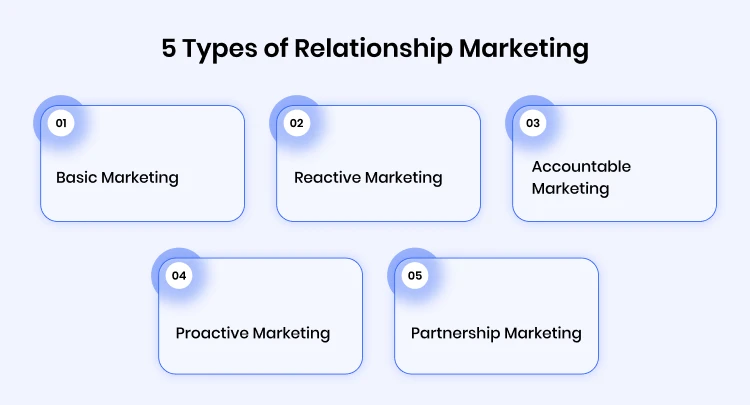
How to Improve Your Relationship Marketing Strategy?
1. Improve Your Customer Service
Poor customer service can result in a bad customer experience. Customer retention becomes a big challenge when customer service is poor. Providing good customer service is the key aspect of a relationship marketing strategy. The main focus of your customer service should be on engaging with customers and ensuring value to them for any question, concern, or complaint they have. To improve your customer service, follow these strategies –- Have an experienced customer service team to handle customer issues
- Train your team to be friendly and respectful towards customers and their situation
- Make your customer service easy to reach
- Let customers use multiple channels to reach you including live chat, email, and social media
- Always be ready to help customers regardless of the time zone, location, and complexity of the matter
2. Listen to Feedback
Listening to customer feedback is one of the most effective ways to improve their overall experience with your brand. Collecting, and action on, feedback is essential when you want to build and nurture customer relationships. When you collect feedback, customers feel cared for and valued. They believe that their voice is heard, and this can help build trust in your brand. Key things to do with customer feedback –- Have a robust feedback management system in place
- Encourage customers to share feedback
- Use social media or email surveys to understand what customers think about your business
- Conduct post-purchase surveys and assess customer’s happiness, or lack of it, with your product
3. Personalize Your Customer Communications
When you communicate with customers, adopting a one-size-fits-all approach won’t work. You need to understand how each customer is unique when it comes to their preferences for communication. This is why you should focus on personalizing your customer communication and tailoring your offers to the needs of each customer. By personalizing the communications, you can create a more engaging experience for your customers and improve their experience with your brand. To personalize your customer communication, you need to take these steps –- Leverage information on the purchase history, behavior, and preferences of your customers
- Create detailed buyer personas for a personalized plan for each segment
- Offer customized content based on the customer’s past interactions with your brand
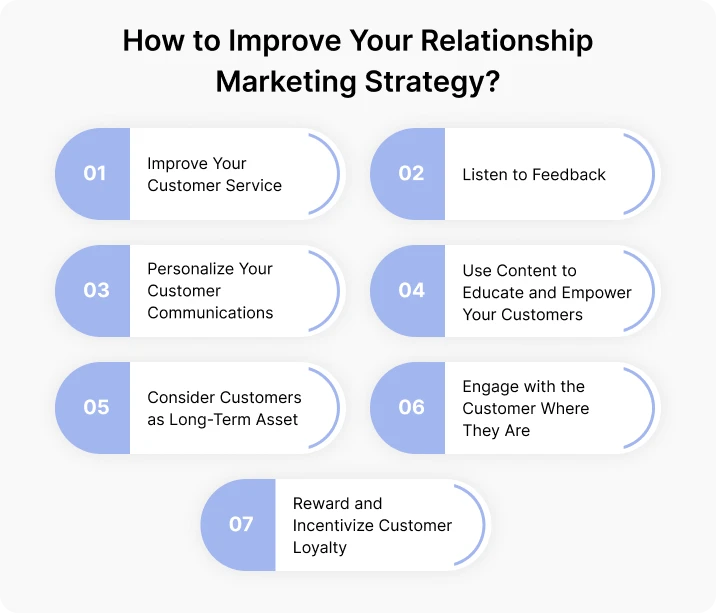
4. Use Content to Educate and Empower Your Customers
Content is a vital part of a relationship marketing strategy. You can leverage various forms of content to educate, inform, and eventually empower your customers. An effective content strategy can help you generate tons of leads as well. You can use diverse types of content such as blog posts, videos, infographics, how-to-guide, etc to build strong connections with your audience. Key strategy you should consider –- Create content with the focus to add value to your audience
- Focus on using content to solve problems and guide customers through solutions
- Use multiple channels to boost engagement with your audience
- Cater to specific customers through personalized content
5. Consider Customers as Long-Term Asset
Relationship marketing can be a strategic approach for your business to maintain strong customer bonds over time. It can help you make enduring connections with your customers by delivering value. When you adopt this form of marketing, it shows you are going to be accountable for your customers and responsive to their needs. Key strategies you should consider –- Treat customers as a long-term investment rather than short-term gains
- Adopt a customer-centric approach with more focus on meeting their needs
- Focus on delivering your promises and commitments
- Position yourself as a trusted source in the industry
6. Engage with the Customer Where They Are
Engagement is always at the core of a successful relationship marketing strategy. To engage with your customers, you need to reach out to them through their preferred channels. It’s therefore important to research the platforms and channels most popular with your audience. After that, you need to make your presence on those platforms where the audience hangs out. This will encourage them to interact and engage with your brand. Key strategies to adopt for engagement –- Work out a multi-channel marketing strategy
- Focus on solving problems of customers across different touchpoints
- Ensure prompt responses to customer messages, comments, and mentions
- Keep customers informed through regular messages and notifications
7. Reward and Incentivize Customer Loyalty
Customer loyalty is a big asset for any business. It’s something you need to work for and earn. The best way to earn customer loyalty is through rewards and incentives. Make sure you have implemented a robust loyalty program to reward your customers. Find out ways to incentivize them after they become customers. Rewarding customer loyalty is an excellent way to foster a long-term relationship with them. Key strategies you should adopt –- Offer a discount on additional products
- Personalize product recommendations based on the search history and preferences of your customers
- Create a point-based loyalty program as it will encourage customers to buy additional products
Customer Relationship Marketing Best Practices
- Prioritize Customer Needs – Successfully meeting customer needs is the foundation of an effective relationship marketing tactic. To meet customer needs, you first need to know what issues they face and then take steps to resolve them. Make sure all your actions put the customer at the focus of your attention. This will help you meet their needs as effectively as it should.
- Always Focus on Adding Value to Customers – Giving customers something of value is the best strategy to build long-lasting relationships with them. The more value you provide, the more commitment you can earn from your customers. If you can’t offer tangible values, ensure your marketing strategies keep customers educated and informed about your products or services.
- Adopt Transparency and Accountability – Customers expect a sense of transparency and accountability from you. So, avoid making false promises, particularly when you know you can’t deliver. Always make commitments to improving things for customers and making their experience better with your brand.
- Make Customers Feel Special – The more you make customers feel special, the deeper bond you will forge with them. You can use customer data to make them feel valued. You can send special offers or wishes on their special days like birthdays, anniversaries, etc.
- Provide Value to Repeat Customers – You should consider giving back something to those customers who make repeat purchases. This will help strengthen long-term relationships with them. Devise a referral and reward program to add value to customers who stick with your business for long.
Relationship Marketing Examples
Customer Loyalty Program of Delta Airlines
The aviation industry is a good place to find and analyze examples of relationship marketing, and the example of Delta Airlines stands out. Its loyalty program – The SkyMiles Program – gives customers a chance to earn “miles” based on the money they spend. Flyers can redeem those miles for future travel and get discounts on journeys. The airline has also partnered with top credit card companies to help customers gain points on their purchases. This loyalty program has proven as a solid relationship marketing strategy, helping the company build a long line of loyal customer base.
Customer Relationship Management of Amazon
Amazon is a worldwide ecommerce leader across markets. Its huge success can be attributed to many factors, but its thoughtful approach and single-minded dedication to reaching out to its customers stand out in the true sense. The company has an algorithm in place to capture shopper’s interactions with the platform and show results based on their interests. While users get a responsive experience when they visit the platform, those with complaints can hope to get a quick resolution from the support team. More so, buyers can leverage reviews and Amazon’s descriptions of products to make informed purchase decisions.
Personalized Rewards Offer of Starbucks
Starbucks has truly transformed the way people get their cups of coffee. The company had a humble beginning but its engagement model and efforts have made it an iconic brand. The way it uses the mobile app and loyalty program to offer personalized rewards is unique in many ways. More so, it regularly engages customers through social media and shows its cups of coffee in social posts. Apart from personalized offers, the company regularly sends out emails to keep its customers informed of the latest offers, offers, and launches. In addition, it uses social channels to connect with customers and answer their queries.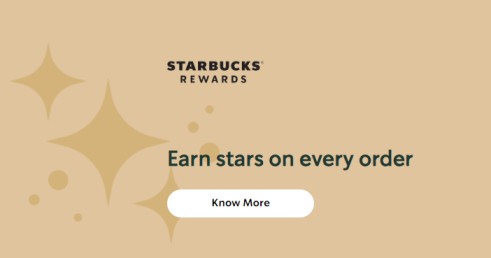
The “Higher-than-Profit” Approach of Patagonia
Brands looking to build profits somehow fail to focus on building relationships with customers. Patagonia is a good example of how to stand for a bigger purpose than profit. This approach has struck a chord with like-minded consumers who always rally behind a brand that demonstrates their values. The company has built an identity on the standing of an environmentally conscious business which has helped it appeal to people who use organic and recycled materials. Among many other radical steps, the company regularly encourages customers to purchase used Patagonia clothing rather than new and also offers clothing repairs and DIY solutions free of charge.
Final Thoughts
Engagement is at the heart of relationships. The more your business engages and interacts with customers regularly, the more opportunities it will create for relationship marketing. At REVE Chat, we understand the huge role played by technology in boosting customer engagement and that’s why we ensure your business is always on par with the needs of the market. With us, you will find a variety of customer engagement tools such as AI-powered chatbot, live chat, video chat, co-browsing software, and a ticketing system.You can sign up with us and check all our tools, analyze their performance, and understand how they can prove a great value addition to your business.Frequently Asked Questions
1. What does relationship marketing mean?
Relationship marketing is a key aspect of Customer Relationship Management (CRM) that prioritizes long-term customer satisfaction over short-term sales targets. It’s a form of marketing that emphasizes customer retention over acquisition and focuses on lifetime customer value. The main goal of relationship marketing is to shift from a sales-centric approach to a customer-centric approach and target customer value.2. What are the key benefits of relationship marketing?
The key benefits of relationship marketing include:- Improved retention rates
- Higher levels of customer satisfaction
- Enhanced word-of-mouth marketing
- Higher conversion rates
- Higher customer loyalty and trust
- Higher CLV
3. Why use relationship marketing?
A business can use relationship marketing to create an army of loyal customers. Such customers stay longer with the business and make repeat purchases, resulting in a higher CLV. In addition, using relationship marketing can help a business turn loyal customers into brand advocates who can contribute through buzz marketing and recommended offers to others.4. What is the goal of relationship marketing?
Helping a business convert existing customers to brand loyalists is the ultimate goal of relationship marketing.5. What are the different types of relationship marketing?
There are 5 different types of relationship marketing:- Basic Marketing
- Reactive Marketing
- Accountable Marketing
- Proactive Marketing
- Partnership Marketing


